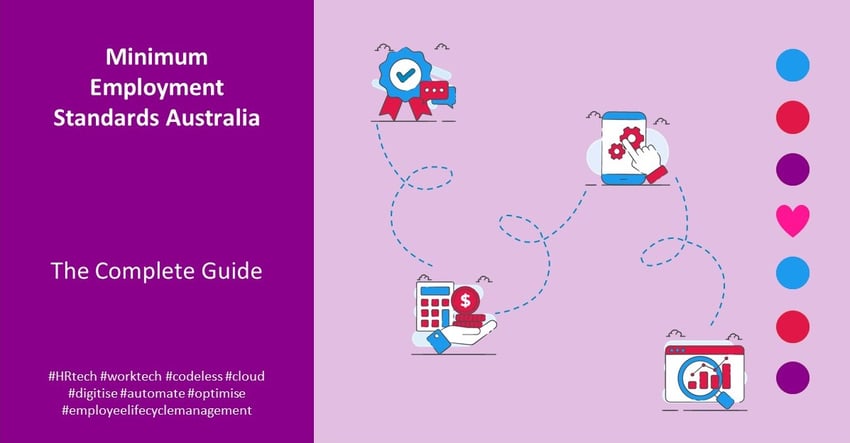Australia has emerged as a thriving destination for global businesses and job opportunities. With its strong economic growth, fueled by diverse sectors like e-commerce and technology start-ups, it attracts companies seeking expansion and a skilled workforce.
But as more and more businesses learn to navigate the Australian market, understanding the country's labour laws, rights and protections they afford to workers is crucial.
A key aspect of Australian labour law is the National Employment Standards (NES). These standards set out the minimum entitlements and provisions that employers must adhere to, ensuring fair treatment and decent working conditions for employees. 👍
In this comprehensive guide to minimum employment standards in Australia, we’ll be exploring each of the 11 standards outlined by the NES.
We will explore the rights and provisions they afford to employees, discuss best practices for employers to comply with these standards, and provide insights and resources to help navigate the complexities of Australian labour law. Let’s dive right in! ⬇️

Understanding the National Employment Standards (NES)
What are the National Employment Standards (NES)?
The National Employment Standards (NES) form a crucial part of Australia's workplace laws. They provide a comprehensive set of minimum employment standards that apply to most employees across the country.
The NES is outlined in the Fair Work Act 2009 and serves as a fundamental framework for promoting fair and balanced working conditions. Its primary purpose is to establish a minimum baseline of entitlements and protections for employees, ensuring they are treated fairly and have access to essential benefits and working conditions.
The NES encompasses 11 key minimum standards that cover various aspects of employment. These standards apply to full-time, part-time, and eligible casual employees, regardless of their industry or occupation. 👇
-
Maximum weekly hours of work
-
Requests for flexible working arrangements
-
Parental leave and related entitlements
-
Annual leave
-
Sick and carer's leave, and compassionate leave
-
Family and domestic violence leave
-
Community service leave
-
Long service leave
-
Public holidays
-
Notice of termination and redundancy pay
-
Fair work information statement and casual employment information statement
These 11 minimum standards cover a wide range of employment aspects. Both employers and employees need to understand and adhere to these standards to promote a harmonious and compliant workplace. 🌿
What are minimum entitlements?
Minimum entitlements refer to the fundamental rights and benefits that employees are legally entitled to receive in the workplace. These entitlements are set out in legislation, such as the National Employment Standards (NES) in Australia, and aim to establish a baseline of fair and reasonable working conditions for all employees.
The Additional Documents That Affect Minimum Entitlements
In addition to the National Employment Standards (NES), other documents may impact or add to the minimum entitlements for employees in Australia. These documents provide further guidance and regulations to ensure fair and equitable treatment in the workplace.
Modern Awards
Modern Awards are industry-specific documents that outline minimum terms and conditions of employment. They cover a wide range of industries and occupations, specifying matters such as pay rates, working hours, and leave entitlements. Modern Awards provide additional standards that employees and employers must adhere to, on top of the NES.
Enterprise Agreements
Enterprise Agreements, also known as enterprise bargaining agreements (EBAs), are agreements made between employers and employees or their representatives. These agreements can vary from workplace to workplace and may provide additional entitlements and conditions above those outlined in the NES or Modern Awards. Enterprise Agreements are negotiated to suit the specific needs and circumstances of a particular organisation.
Employment Contracts

Employment contracts are legally binding agreements between employers and employees. Both parties agree on the terms and conditions of employment, including their duties, rights, and responsibilities. Contracts can have provisions beyond NES's minimum entitlements, like extra leave, performance-based incentives, or flexible hours.
Policies and Procedures
Many organisations have their internal policies and procedures that govern various aspects of employment. These documents can address matters such as code of conduct, anti-discrimination policies, grievance procedures, and performance management guidelines. While these policies cannot reduce or undermine the minimum entitlements under the NES, they can provide additional protections and benefits for employees.
State and Territory Legislation
In addition to federal laws, each state and territory in Australia has its own legislation that may impact employment entitlements. These laws can cover areas such as long service leave, public holidays, and occupational health and safety. Employers and employees need to be aware of the specific legislation applicable in their jurisdiction to ensure compliance with all relevant requirements.
Now that we’ve covered the basics, let’s look into each one of the employment standards in Australia! 🔍
Maximum Weekly Hours of Work
There is a maximum limit on the number of hours an employee can work in a week, in order to protect the well-being of employees and promote work-life balance. In Australia, this limit is set at 38 hours per week, with reasonable additional hours as needed. ⬇️
Why is it important to maintain a work-life balance?
Maintaining a work-life balance is crucial for the physical and mental health of employees. Overworking can lead to burnout, decreased productivity, and adverse health effects. With a maximum weekly limit, employees can recharge, spend time with family and friends, and engage in personal activities outside of work. ☺️
Are there any circumstances where additional hours are allowed?
However, there may be certain circumstances where reasonable additional hours are required. For example, during peak workloads or emergencies, employees may need to work extra hours to meet deadlines or address urgent matters. Employers need to communicate the reasons behind these additional hours and ensure they are necessary and reasonable.
How can employers promote work-life integration and create supportive work environments?
Employers have a crucial role to play in promoting work-life integration and creating nurturing work environments. Some great ways to start are flexible work arrangements such as remote work options or flexible scheduling to accommodate employees’ personal needs.
It is important to note that employees have the right to refuse excessive work hours beyond the maximum limit. Employers can face penalties for non-compliance with employment standards if they consistently exceed the maximum weekly hours or fail to provide reasonable additional hours when necessary.
Employers and employees need to communicate openly regarding workload and hours worked. Employers should frequently check in with employees to ensure they can manage their workloads and address their concerns about excessive work hours. This will lead employees to feel confident discussing their workload and raising issues related to their working hours. 👍

Flexible Working Arrangements
Certain employees have the right to request changes to their working arrangements. This provides an opportunity for employees to achieve a better work-life balance and meet personal obligations while fulfilling their professional responsibilities. 🙌
What is the employer's obligation to consider and respond to such requests?
Employers must consider these requests in a reasonable and timely manner. They should assess the feasibility and impact of the proposed changes, taking into account operational requirements and the needs of the business. While not all requests will necessarily be granted, employers should provide clear and transparent reasoning for their decisions.
What are the benefits of flexible work arrangements for employees and employers?
Implementing flexible work arrangements can bring significant benefits for both employees and employers. For employees, it allows for greater autonomy and control over their work schedule, reducing stress and improving overall job satisfaction. It enables them to better manage personal commitments, such as childcare, education, or health-related needs.
Employers can also reap numerous advantages from implementing flexible work arrangements. It can enhance employee engagement, retention, and productivity. Flexible arrangements often lead to increased employee loyalty and motivation, as employees feel valued and supported by their organisation.
What are the different types of flexible working arrangements?
Different types of flexible working arrangements can be considered, such as remote work, part-time work, compressed workweeks, job sharing, or flexible scheduling. Employers need to develop clear and inclusive policies that outline the available options and guidelines for requesting flexible work.
How can organisations develop clear and inclusive policies for flexible work?
Open communication between employees and managers is crucial for the successful implementation of flexible work arrangements. Employers need to strive for a culture that values and supports flexible work options, encouraging employees to discuss their needs and preferences openly. Managers should be trained to effectively manage flexible teams, ensuring productivity and collaboration while maintaining work standards.
How can fair and equitable treatment be ensured for all employees, regardless of their work arrangements?
It's essential to identify and address potential challenges or concerns that may arise from implementing flexible work arrangements. This could include issues related to communication, coordination, or potential inequalities among employees. Employers need to ensure fair and equitable treatment of all employees, regardless of their work arrangements, to maintain a positive work environment.
✨ We recommend regular monitoring and evaluation of policies and practices related to flexible work arrangements. This allows for adjustments and refinements based on employee feedback and changing business needs.
Parental Leave and Related Entitlements
In addition to the initial twelve months of parental leave, employees may request an additional twelve months of unpaid leave. This extended period allows parents to have even more dedicated time to bond with their children and fulfil their caregiving responsibilities. Employees who adopt a child are entitled to adoption-related leave, which grants them the necessary time to establish a bond with their newly adopted child.
It is undeniable that parental leave is a critical part of nurturing and developing strong family relationships. It allows parents to devote quality time to establish emotional connections and a nurturing environment for their child, be it a newborn or an adopted one. On top of that, parental leave also has positive impacts on the child's growth, as it gives parents the chance to be physically present to ensure their children's well-being, social development, and cognitive growth.
But parental leave is not only beneficial for the children, it is also of great value to the parents. With parental leave, both mothers and fathers can take an active role in caring for their children, whilst also maintaining their professional aspirations. What's more, it contributes to gender equality in the workforce, breaking down gender stereotypes and creating a more inclusive work environment.
It is important to remember that parental leave is protected by legal safeguards, meaning that employers cannot treat their employees unfairly or discriminately during this time. In some countries, government schemes, such as Paid Parental Leave, also provide financial assistance to employees during their leave.
When informing employers about parental leave, it is recommended to do so early and in writing. This enables employers to plan ahead and make necessary arrangements. Open communication and early planning are essential in the parental leave process, ensuring that both employers and employees benefit from it.
Annual Leave
Annual leave is an invaluable benefit for employees, allowing them to take a break from work and refresh themselves. Every year, they are entitled to 4 weeks of paid leave with their regular salary, ensuring that their finances remain unaffected. For shift workers, this entitlement is even higher - they can typically get an extra week of leave to maintain their work-life balance.
Employees should plan their leave in advance, taking into account personal commitments, team workloads, and travel plans. Employers play a vital role too, approving and coordinating requests while ensuring fairness and balance among their employees. Leave is beneficial for both employers and employees alike - not only does it promote overall wellbeing, but it can also help reduce stress and improve productivity and creativity upon the employee's return.
Employees should use their leave to prevent burnout, keep up their mental health, and achieve a better work-life balance. They should pursue activities they enjoy, spend quality time with family and friends, and take the time to relax and recharge. It is the responsibility of employers to make sure their staff are aware of their entitlement and can enjoy their leave without fear of negative repercussions. They should ensure their leave policies are clearly communicated, and provide guidance and fair processes for managing and approving requests.

Sick and Carer's Leave, and Compassionate Leave
Sick and carer's leave, as well as compassionate leave, are essential benefits that allow employees to take time off when they or their loved ones face health-related challenges.
Employees generally receive 10 days of paid sick and carer's leave per year that can be used when they are unwell or need to care for a family/household member with an illness or requiring care. Sick leave is for unwell employees who are unable to perform their work due to illness or injury, while carer's leave is for employees taking care or offering support to a family/household member in need.
Apart from paid sick and carer's leave, there are also provisions allowing up to 2 days of unpaid leave for carers and time off without pay for personal emergencies such as the death or serious illness of a family member or close friend.
When taking any of these leaves, employees should promptly inform their employer and provide the necessary documentation, which could include a medical certificate or supporting documentation for compassionate leave.
Sick, carer's, and compassionate leave are critical in promoting work-life balance. Employers, who should ensure compliance with all entitlements, can adopt clear policies and procedures, flexibility, and empathy to create a supportive work environment for employees in challenging times.
Family and Domestic Violence Leave
Family and Domestic Violence Leave is a vital right that recognizes the effect of domestic violence on employees and gives them the support they need during challenging times. Employees who are affected by family and domestic violence are entitled to 10 days of paid leave each year, which they can use to attend to their personal circumstances, obtain support, and take the necessary steps to safeguard their safety and wellbeing.
Family and Domestic Violence Leave acknowledges the fact that domestic violence can cause serious physical, mental, and emotional trauma that might require time away from work for recovery. Employers must maintain the confidentiality and privacy of employees who avail of this leave, and create a safe environment where employees feel comfortable discussing their situation without fear of judgement or repercussions.
Giving paid leave for family and domestic violence shows employers' commitment to supporting their employees' well-being and safety. This lets individuals access the resources and help they need, such as getting medical attention, participating in counselling, looking for alternative housing, or attending court proceedings.
Employees may be asked to provide reasonable notice to their employer regarding their need for Family and Domestic Violence Leave. These requirements for notification and documentation may vary depending on company policies and applicable laws, but employers should be understanding and flexible, knowing the delicate nature of the situation.
Employers can establish a supportive working environment by introducing policies and procedures concerning family and domestic violence. This includes making resources and information available and referring employees to support services such as counselling, legal aid, and community organisations. Furthermore, they can arrange training programs for managers and staff to recognise and respond to domestic violence.
Employees taking Family and Domestic Violence Leave are shielded by laws and regulations that prevent discrimination or negative treatment due to their circumstances. Employers must abide by these legal requirements and ensure that employees feel protected and supported throughout the process.
Community Service Leave
Unpaid leave allows employees to actively serve their communities during times of crisis, or to fulfill their civic duties as jurors without facing negative consequences.
Additionally, employees may be eligible for paid leave for up to 10 days for jury service, which can help alleviate the financial burden. To ensure impartial treatment of employees and compliance with legal requirements, employers should be familiar with applicable laws and regulations concerning Community Service Leave.
Furthermore, clear communication between employers and employees is essential to facilitate a successful process for granting Community Service Leave, so that employees can take part in voluntary emergency activities or jury service without issue.
Long Service Leave
Reward your employees for their loyalty and long-term commitment with Long Service Leave - a valuable benefit that offers paid time off work as a sign of dedication.
Eligibility criteria may vary depending on the jurisdiction, but generally, it's after a certain number of years or months of continuous service with the same employer. Accrual of Long Service Leave is gradual over time, with entitlements expressed in terms of weeks or months of paid leave, and breaks in service could affect the calculation of entitlements.
Employees must give their employer advance notice of their intention to take Long Service Leave and employers must ensure that employees' rights are protected by understanding all the requirements.
Public Holidays
Public holidays can be a time to celebrate, rest, and be with family - and depending on the country, region, or employment laws, employees may be eligible to receive a paid day off.
Casual employees, however, may not be granted this benefit, but can still receive their usual payment for hours worked or negotiate a higher rate of pay. Working on public holidays is not a given, but can be requested by employers in certain sectors that need to maintain services even on public holidays, in which case additional remuneration or other benefits may be provided.
Employers must ensure compliance with the relevant regulations when it comes to public holidays, such as correctly identifying and observing them, and providing employees with the necessary information and entitlements. Plus, they must guarantee fair and equitable treatment for all workers when it comes to public holidays.
Notice of Termination and Redundancy Pay
What is Notice of Termination and how does it work?
When it comes to the termination of employment, there are specific requirements regarding providing notice to employees.
Employers are generally required to provide employees with a notice period before terminating their employment. The length of the notice period depends on various factors, including the length of service of the employee and the applicable employment laws. In some cases, notice periods can range from a minimum of one week to up to five weeks or more, depending on the circumstances.
The length of service with the employer often determines the notice period required. Typically, longer service periods result in longer notice periods. This is to ensure that employees have sufficient time to make necessary arrangements and seek alternative employment if their position is being terminated.
It's important to note that there may be minimum notice periods prescribed by employment laws, even for employees with shorter lengths of service. Employers must be aware of these minimum requirements and ensure compliance with the applicable legislation.
In some cases, employment contracts may contain provisions specifying notice periods that differ from the statutory minimums. If such contractual agreements exist, employers must adhere to the terms outlined in the employment contract.
What is Redundancy Pay and how does it work?
Redundancy pay is a form of financial compensation provided to employees in the event that their employment is terminated due to redundancy.
Redundancy occurs when an employee's position is no longer required by the employer due to various reasons such as business restructuring, technological advancements, or economic factors. It is important to note that redundancy is distinct from other forms of termination, such as dismissal for poor performance or misconduct.
The length of service with the employer is a critical factor in determining the entitlement to redundancy pay. The longer an employee has worked for the employer, the higher the redundancy pay they may be entitled to receive.
The specific calculation method for redundancy pay may vary based on the applicable employment laws. It typically involves taking into account the employee's length of service, age, and the relevant redundancy pay scale or formula established by the legislation.
There is often a maximum limit on the amount of redundancy pay an employee can receive based on their length of service. The maximum entitlement can range from a few weeks' pay to a specified number of weeks, depending on the jurisdiction and legislation.
Some employees may be exempt from receiving redundancy pay, such as casual employees, fixed-term contract employees, or employees who have been employed for a short period. It's important to refer to the relevant legislation or seek legal advice to determine the specific entitlements in these cases.

Fair Work Information Statement and Casual Employment Information Statement
The Fair Work Information Statement
The Fair Work Information Statement is an important document that employers in Australia are required to provide to all new employees. It serves as a concise and comprehensive resource that informs employees about their rights, entitlements, and obligations under the Fair Work Act 2009. It helps employees understand their employment conditions and the legal framework that governs their employment.
Employers have a legal obligation to provide the Fair Work Information Statement to all new employees. The statement must be given to employees as soon as possible after they commence employment, ideally before or as part of their induction process.
The Fair Work Information Statement contains important information about various aspects of employment, including the National Employment Standards (NES), minimum wages, leave entitlements, termination of employment, workplace rights and protections, and the role of the Fair Work Commission. It also provides guidance on resolving workplace disputes and accessing additional sources of information and support.
The Casual Employment Information Statement
In addition to the Fair Work Information Statement, there is a specific Casual Employment Information Statement that employers must provide to casual employees.
The Casual Employment Information Statement is designed to provide casual employees with specific information about their rights, entitlements, and obligations as casual workers. It aims to ensure that casual employees are aware of their employment conditions and understand their rights under the Fair Work Act 2009.
Employers are required to provide the Casual Employment Information Statement to all new casual employees. Similar to the Fair Work Information Statement, the Casual Employment Information Statement should be provided to casual employees as soon as possible after they commence employment, preferably during their induction process.
The Casual Employment Information Statement highlights key aspects of casual employment, such as the nature of casual employment, the right to request conversion to permanent employment, casual loading, and provisions related to overtime and penalty rates. It also provides information on how casual employees can seek further advice or assistance if needed.
Casual Conversion
Do you have a casual employee that has been with your business for a while? If so, they may be eligible to convert to a permanent employee!
This process, known as casual conversion, offers several benefits to employees, including greater job security, paid leave, access to long service leave, and more. Different industrial instruments may have different eligibility criteria, but common requirements may include a minimum period of continuous employment as a casual employee, a regular pattern of work, and no reasonable grounds for refusal.
When considering a casual conversion request, employers should be sure to treat it fairly and act in accordance with the applicable laws and regulations. Open communication and fairness during the process can help create a positive relationship with employees and contribute to a more stable and engaged workforce.
Takeaway: Navigating Minimum Employment Standards in Australia
It is essential for both employers and employees in Australia to understand and adhere to the National Employment Standards (NES) for the sake of fair and safe working conditions.
In this article, we have taken an in-depth look at the NES, which covers topics such as maximum weekly hours, flexible working arrangements, parental leave, annual leave, sick and carer's leave, family and domestic violence leave, community service leave, long service leave, public holidays, notice of termination and redundancy pay, the Fair Work Information Statement, and the Casual Employment Information Statement.
The key messages to take away from this discussion are:
-
Employers should familiarize themselves with the NES and make sure they are meeting their legal obligations
-
Employees should know their rights and ensure they are communicated with their employer to secure those rights
-
Both parties should maintain open communication to sustain a healthy workplace
-
Employers should devise clear policies regarding minimum entitlements, including processes for leave requests and termination and redundancy cases
-
Compliance with the NES is not only legally required, but also contributes to cultivating a fair and equitable working environment that appreciates employees and their rights
-
If employers have any queries, they should seek professional help from human resources specialists or employment lawyers.
Want to find out more about Australian HR law? Check out the Subscribe-HR Blog! ⭐

